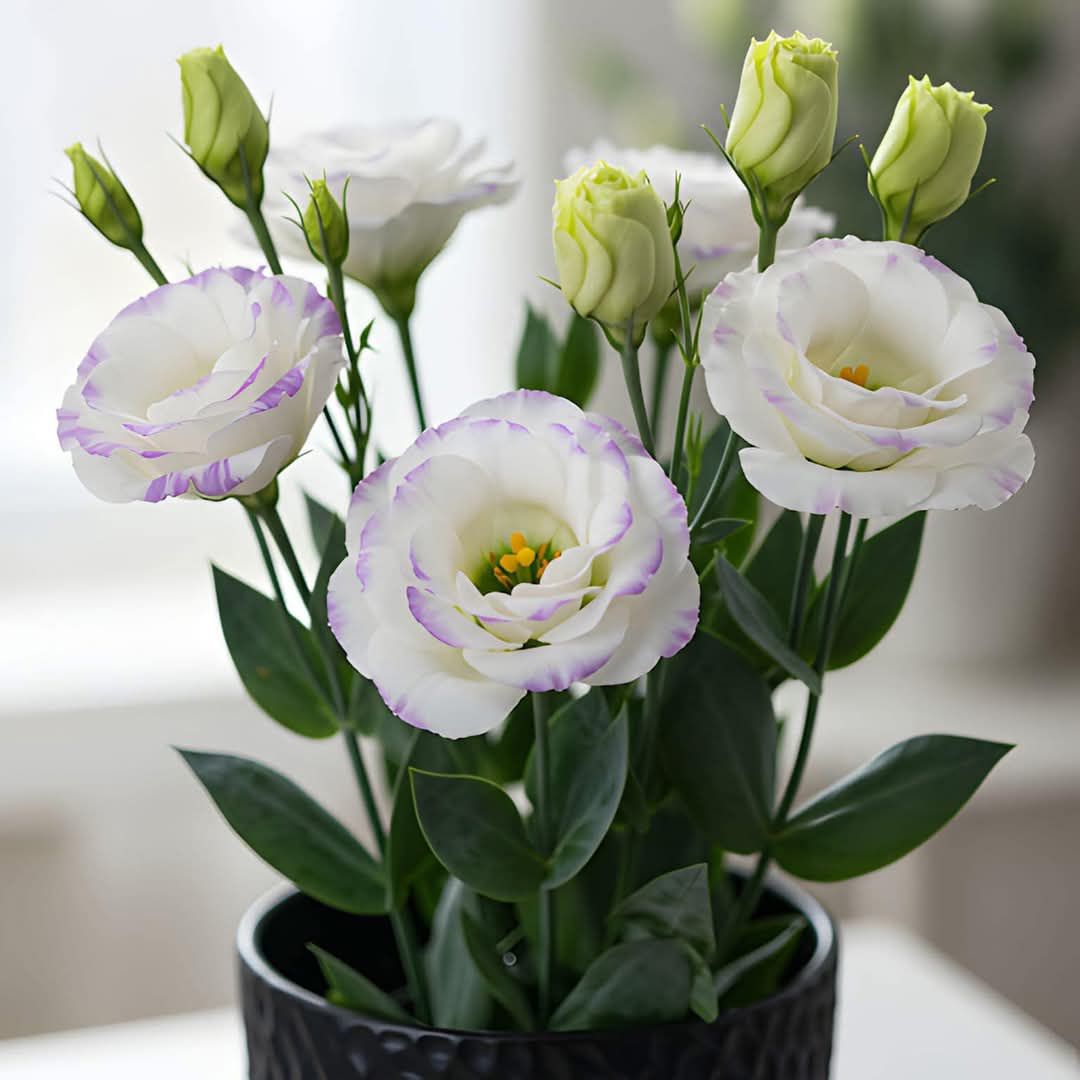Lisianthus, also known as Eustoma, is a stunning flowering plant that blooms in vibrant shades of purple, pink, white, and blue. These flowers are known for their delicate petals and elegant appearance, making them popular in gardens and floral arrangements. To ensure the healthiest growth and most beautiful blooms, it’s important to provide Lisianthus with the right growing conditions.
1. Sunlight
Preferred Light: Lisianthus thrives in full sun to partial shade. A sunny location will promote healthy growth and abundant flowering. However, in hot climates, it’s beneficial to provide some afternoon shade to prevent the plant from overheating.
Ideal Conditions: Aim to place Lisianthus where it will receive at least 6 hours of sunlight per day. In regions with intense summer heat, the plant can benefit from light afternoon shade to help it flourish without becoming stressed.
2. Soil
Well-Drained Soil: Lisianthus requires well-drained soil to avoid root rot. They do best in soil that is fertile and light with good organic matter content.
Soil pH: A slightly acidic to neutral pH (around 6.0 to 7.0) is ideal. You can amend the soil with compost to improve texture and drainage, ensuring the roots have room to grow and access nutrients.
3. Temperature
Moderate Temperatures: Lisianthus grows best in moderate temperatures ranging between 60-80°F (15-27°C). They prefer warmth but not extreme heat.
Frost Sensitivity: Lisianthus is not frost-tolerant, especially when the plants are young. If you live in a region with cold winters, consider growing them as annuals or starting them indoors before the last frost. Once the danger of frost has passed, you can transplant them into the garden.
4. Watering
Consistent Moisture: Lisianthus requires regular watering, especially during dry spells, to keep the soil consistently moist. However, overwatering should be avoided, as they are prone to root rot if left in soggy soil.
Watering Tips:
Water the plant deeply, but allow the top inch of soil to dry out slightly between waterings.
Water at the base of the plant to avoid wetting the foliage, which can encourage fungal issues.
Be mindful during periods of heavy rain—ensure the soil drains well and doesn’t remain waterlogged.
5. Fertilizing
Feeding Lisianthus: To promote strong growth and long-lasting blooms, feed your Lisianthus plants with a balanced fertilizer every 4-6 weeks during the growing season (spring to early fall).
Fertilizing Tips:
Use a slow-release fertilizer to avoid overfeeding the plant.
If you’re growing Lisianthus in containers, consider switching to a water-soluble fertilizer every 3 weeks to ensure a consistent nutrient supply.
6. Support
Taller Varieties: Some Lisianthus varieties, especially the taller ones, may require support to prevent them from flopping over. You can use stakes, cages, or trellises to keep the stems upright as the plant matures.
Supporting Tips:
Be gentle when tying plants to stakes, as Lisianthus stems can be delicate.
Position support structures early to avoid damaging the roots later on.
7. Pinching
Encouraging Branching: To encourage bushier growth and more blooms, pinch back young plants. This process involves removing the tips of the stems to promote side branching and better flowering.
Pinching Tips:
Pinch off the top 2-3 inches of the main stem once the plant has developed 3-4 sets of leaves.
This will encourage the plant to produce multiple flower stems instead of just one, resulting in a fuller, more vibrant display.
8. Disease and Pest Control
Pests to Watch Out For: Lisianthus is susceptible to pests such as aphids, whiteflies, and spider mites. Regularly inspect the plants for signs of infestation and treat them with insecticidal soap or a natural pest control method like neem oil.
Fungal Diseases: These plants are also vulnerable to fungal diseases like powdery mildew and root rot. Ensure the soil is well-drained, avoid overhead watering, and remove any infected leaves or stems promptly.
Preventive Care:
Avoid watering the foliage to reduce fungal issues.
Keep the area around the plants clean and remove any debris that could harbor pests.
Additional Tips for Growing Lisianthus Successfully
Starting from Seed: Lisianthus can be a bit slow to germinate, so it’s recommended to start seeds indoors about 8-10 weeks before the last frost. They require warmth to germinate, with temperatures around 70-75°F (21-24°C).
Transplanting: Once the seedlings are large enough to handle and the danger of frost has passed, transplant them into the garden or larger containers. Be gentle to avoid disturbing the roots.
Flowering: Lisianthus blooms in mid to late summer, and the flowers can last for several weeks. You may notice that flowers open in succession, giving you a prolonged blooming period. Pruning spent blooms can encourage further flowering.
By following these growing conditions and tips, you can ensure your Lisianthus plants remain healthy and produce beautiful blooms year after year. Whether you’re growing them for garden decoration or to bring inside as cut flowers, Lisianthus will reward you with its elegant flowers and vibrant colors throughout the growing season. 🌸🌿
More Articles You Might Like
-
Texas Toast Sloppy Joes: The Crunchy, Cheesy Upgrade You Didn’t Know You Needed
There’s something timeless about sloppy joes. For generations, this saucy, savory, and slightly sweet ground beef sandwich has been a go-to comfort food in American kitchens. It’s quick, filling, and family-friendly—perfect for busy weeknights. But what if we told you there’s a way to take this classic dish up a notch? Enter the Texas Toast…
-
Classic Pig Pickin’ Cake
When it comes to Southern desserts, few sweets shine as brightly as the Classic Pig Pickin’ Cake. This nostalgic cake, sometimes called a “Mandarin Orange Cake,” has roots deep in Southern tradition. It gets its playful name from its frequent appearance at pig pickin’s—Southern-style barbecue gatherings where communities come together to enjoy slow-cooked pork, sides,…
-
Lemon Garlic Butter Chicken with Creamy Parmesan Pasta
There’s something irresistible about the combination of tender, golden-browned chicken paired with a creamy pasta coated in Parmesan cheese. Add the brightness of lemon, the depth of garlic, and the richness of butter, and you have a recipe that feels indulgent yet approachable enough for a weeknight dinner. Lemon Garlic Butter Chicken with Creamy Parmesan…



